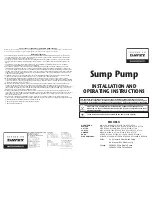
4-6
BOP-1K 031912
2. Set the BOP to zero volts output by sending
CAL:VOLT ZERO
. Connect a Digital Voltmeter
(DVM) to the BOP OUT S and COM S terminals to measure the output voltage. Send
CAL:DATA
commands as needed (see PAR. 4.3a) to adjust the BOP output until the DVM
reads as close to zero as possible within tolerance specified in Table 4-3 for VOLTAGE
ZERO.
3. Set the BOP to maximum positive output voltage by sending
CAL:VOLT MAX
. Measure the
voltage output using the DVM. To adjust, send
CAL:DATA
commands as needed (see PAR.
4.3b) until the DVM reading is as close as possible above the nominal full scale value within
the tolerance specified in Table 4-3 for +FULL SCALE VOLTAGE.
4. Set the BOP to maximum negative output voltage by sending
CAL:VOLT MIN
. To adjust,
send the
CAL:DATA
command as needed (see PAR. 4.3b)
until the reading is as close as
possible above (absolute value) the nominal full scale value within the limits specified in
Table 4-3 for –FULL SCALE VOLTAGE.
5. Send
CAL:VPR MAX
to adjust the maximum positive voltage protection limit of the power
supply. Send the
CAL:DATA
commands as needed (see PAR. 4.3c)
until the reading is as
close as possible above the nominal full scale value within the limits specified in Table 4-3 for
+FULL SCALE VPR LIMIT.
6. Send
CAL:VPR MIN
to adjust the maximum negative protection limit of the power supply.
Send the
CAL:DATA
commands as needed (see PAR. 4.3c)
until the reading is as close as
possible above (absolute value) the nominal full scale value within the limits specified in
Table 4-3 for –FULL SCALE VPR LIMIT.
7. Connect a 0V ±0.1mV d-c reference to pin 11 (EXT_REF) referenced to pin 10 (SGND) of
the Analog I/O Port connector (A2A5J6). Set the BOP to zero volts output by sending
CAL:VEXT ZERO
. Connect the DVM to the BOP output and send
CAL:DATA
commands as
needed (see PAR. 4.3a) to adjust the BOP output until the DVM reads as close to zero as
possible within tolerance specified in Table 4-3 for VOLTAGE ZERO.
NOTE: Accuracy of the 10V d-c reference must be ±0.1mV in order for the calibrated unit to
meet published specifications.
8. Replace 0V reference at pin 11 (EXT_REF) of the Analog I/O Port connector (A2A5J6) with a
+10V d-c reference. Set the BOP to maximum positive output voltage by sending
CAL:VEXT
MAX
. Measure the voltage output using the DVM. To adjust, send
CAL:DATA
commands as
needed (see PAR. 4.3b) until the DVM reading is as close as possible above the nominal full
scale value within the tolerance specified in Table 4-3 for +FULL SCALE VOLTAGE.
9. R10V reference at pin 11 (EXT_REF) of the Analog I/O Port connector (A2A5J6)
with a 0V ±0.1mV d-c reference. Set the BOP to zero volts output by sending
CAL:VGA
ZERO
. Connect DVM to the BOP OUT S and OUT COM terminals to measure the output volt-
age. Send
CAL:DATA
commands as needed (see PAR. 4.3a) to adjust the BOP output until
the DVM reads as close to zero as possible within tolerance specified in Table 4-3 for VOLT-
AGE ZERO.
10.Replace 0V reference at pin 11 (EXT_REF) of the Analog I/O Port connector (A2A5J6) with a
+10V d-c reference. Set the BOP to maximum positive output voltage by sending
CAL:VGA
MAX
. Measure the output voltage using the DVM. To adjust, send
CAL:DATA
commands as
needed (see PAR. 4.3a) until the DVM reading is as close to zero as possible within toler-
ance specified in Table 4-3 for VOLTAGE ZERO.
Summary of Contents for BOP-MG
Page 2: ......
Page 10: ......
Page 20: ...x BOP 1K 031912 FIGURE 1 1 HIGH POWER BOP SERIES POWER SUPPLY...
Page 37: ...BOP HIPWR 031912 1 17 FIGURE 1 3 BOP OUTPUT CHARACTERISTICS...
Page 53: ...BOP HIPWR 031912 2 15 FIGURE 2 4 PARALLEL CONFIGURATION LOCAL SENSING TYPICAL...
Page 54: ...2 16 BOP HIPWR 031912 FIGURE 2 5 PARALLEL CONFIGURATION REMOTE SENSING TYPICAL...
Page 64: ......
Page 132: ......
Page 192: ......















































